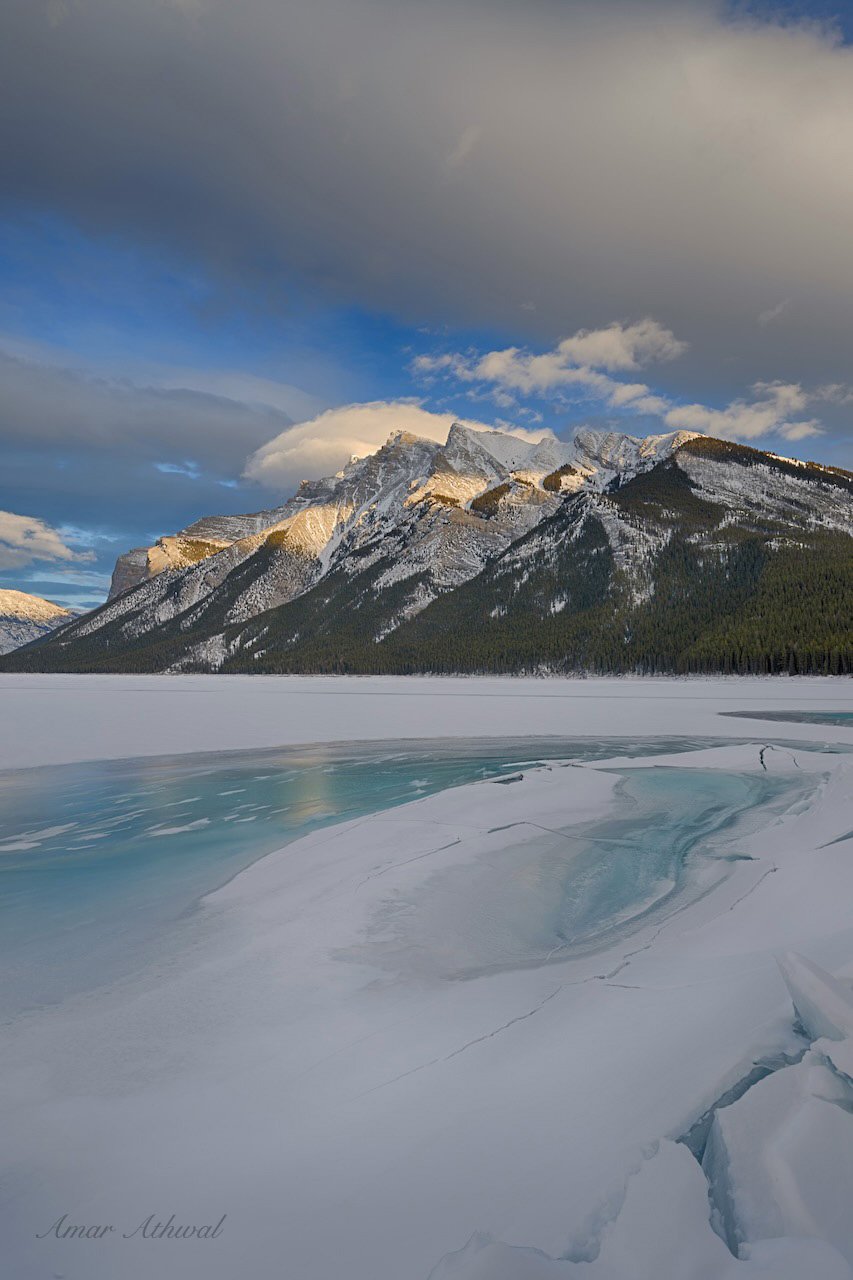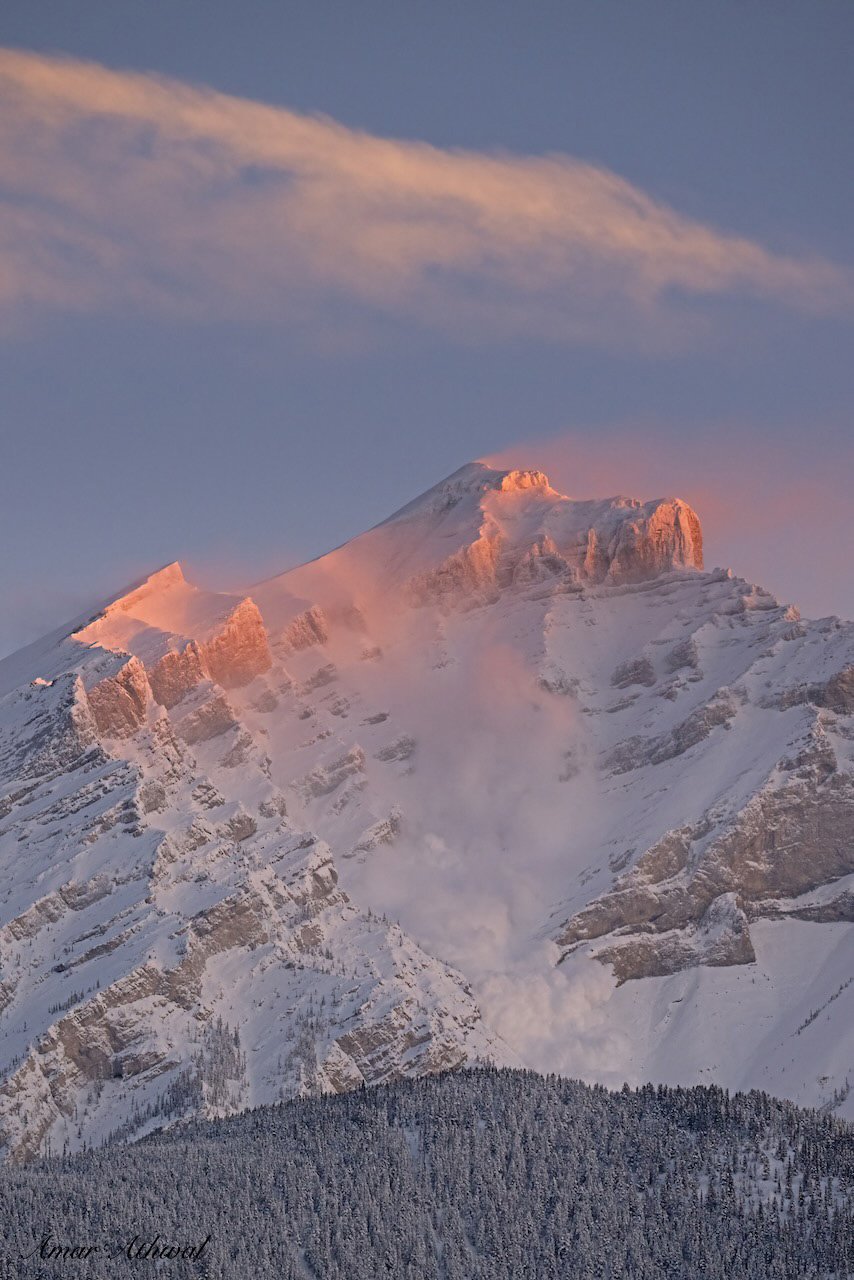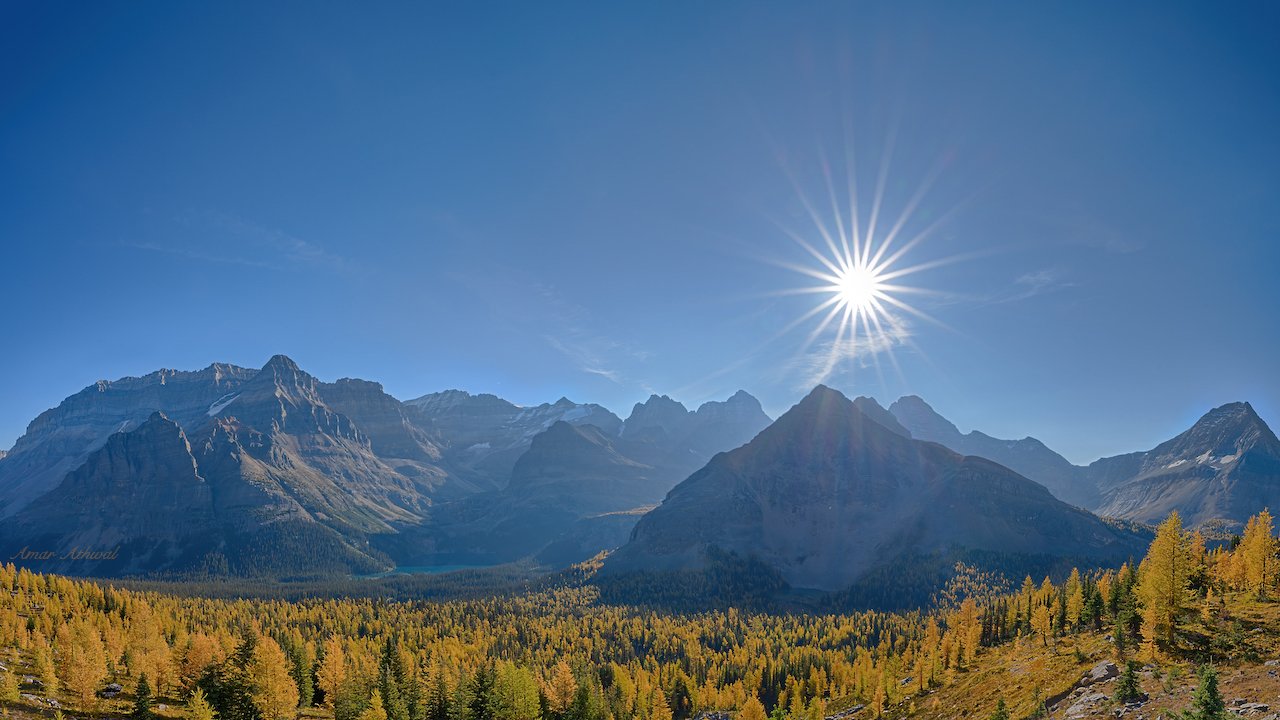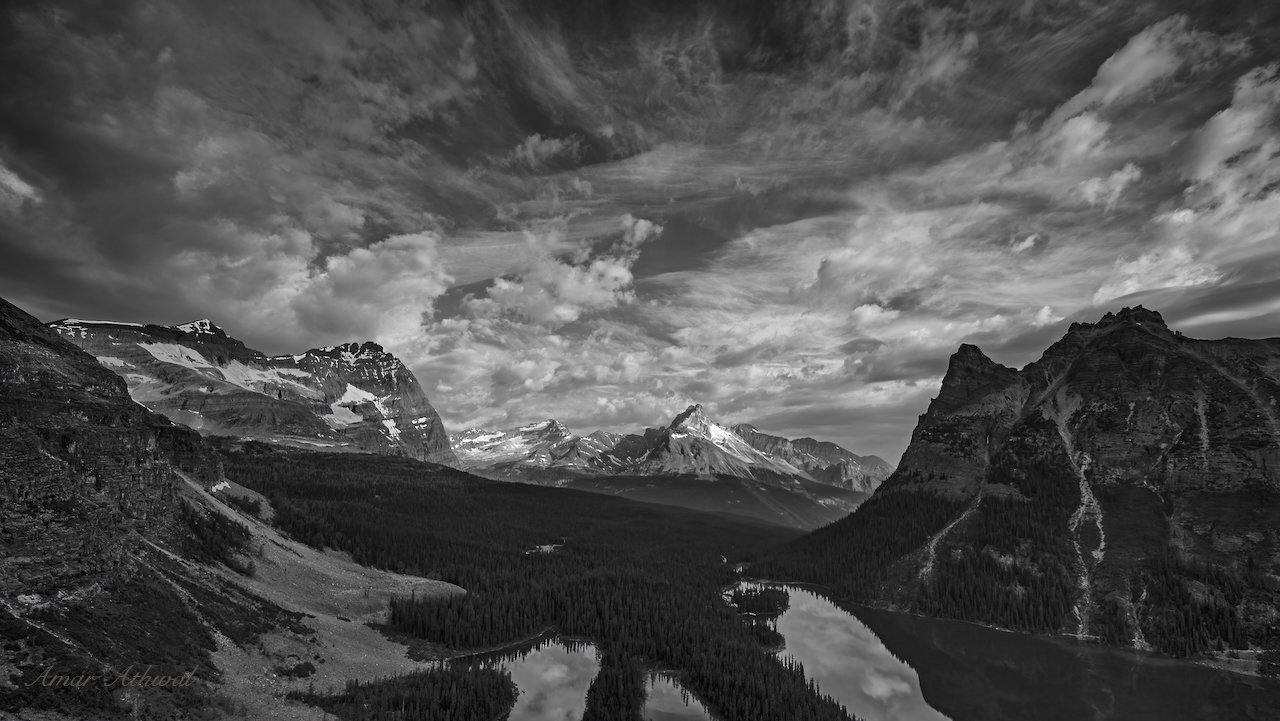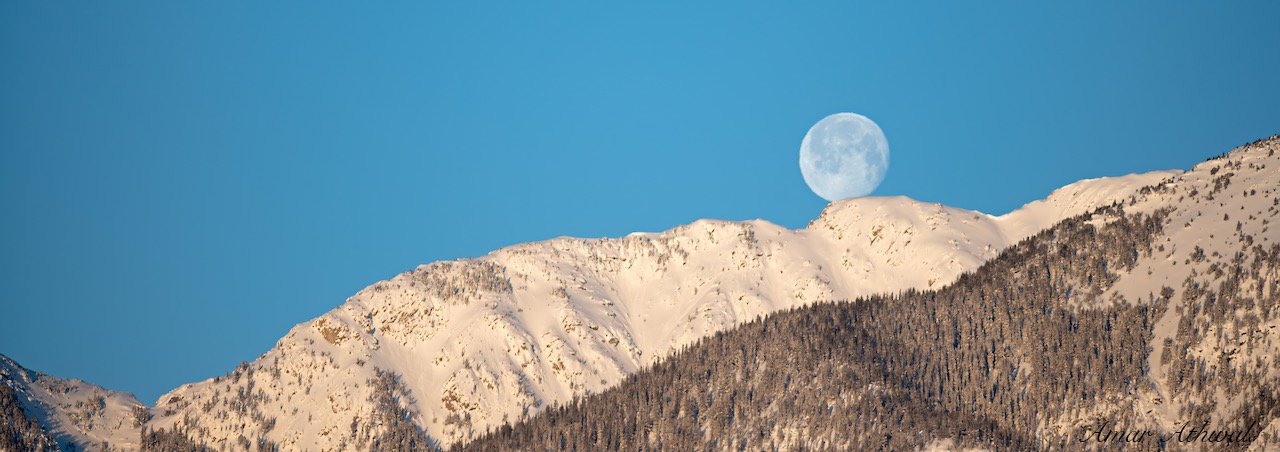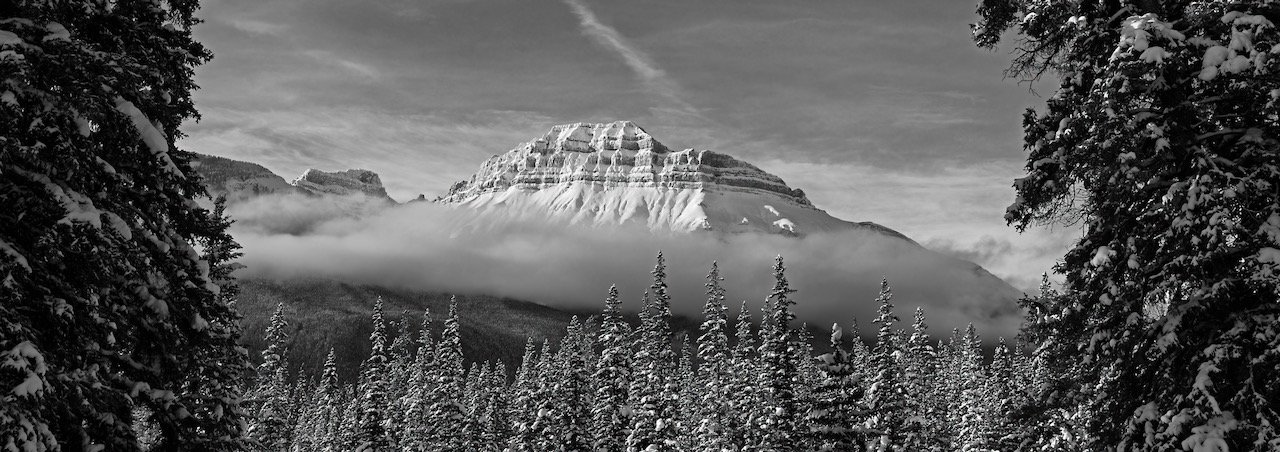Things are changing fast now as spring pushes through. This sunset picture was taken just a couple of weeks ago, as I was looking for a spot with some calm water. Well before the sunset, the sky was already showing some red colour. I just needed to find a spot where the wind would be blocked off by the landscape. The ice was getting weaker, so I also had to make sure I was taking little to no risk where I stood on parts of the frozen river. Just the morning before, about a hundred meters down the river from my location, over seventy elk had crossed the river. Two days after this picture, there was not enough ice for a coyote to cross in the same area. Warmer temperatures, open water absorbing more heat, longer days and the sun getting higher up in the sky each day. All factors helped to open the river for the incoming birds from the south. Even with the three nights of low temperatures we are currently going through, other than needing an extra layer, the day’s temperature is keeping the water open. Providing more places to observe waterfowls after the sunrises.
Mount Fairview
When I’m out to take pictures of wildlife, I’m hoping for clear weather with good lighting. But under the same weather for landscape photography, the camera stays in the bag. You do not just want to take pictures of the mountains, but also the mood created by the combination of the landscape, clouds, shadows, and light. The more time you spend taking pictures, the more refined your style becomes. I’m finding it now, particularly when it comes to landscape photography. Well, even when it comes to flora and fauna, certain conditions must be met before the camera comes out. Photography is like any other skill in life. Over time, you start getting a better sense of what the final image is going to look like before you even take the picture. If you know the image will be good, you take the picture. And if you are unsure, you might take the image. For the rest of the situations, the camera stays put and you keep moving. Otherwise, you are not going to get far on a hike.
Mount Inglismaldie
If I could only give one reason why I go out in nature, it would be to feel better. No matter what my mood was before I stepped out, I always feel better after a walk on the trails. And I am sure many of you can relate to that. Studies are starting to back this up. Including one indicating the nature's colours green and blue reduces stress, improves our moods, brings us with positive emotions and brings down our anxiety levels. One study found that even after 40 seconds of looking at a green roof, we make fewer mistakes in a test. And in my case, making sure I can calculate the exact change for my chocolate purchase. These were just some of the things covered in November by The Guardian article titled: “The nature cure: how time outdoors transforms our memory, imagination and logic.”
Various indigenous communities across the world have learned there are many plants that can be used as medicine, and more is being discovered through research today. But one of the best cures is a simple walk in the park.
Fairholme Range
I rarely have people in nature pictures I take. When I do, other than at work or social gatherings, they are there naturally and are not aware they are getting their picture taken. It’s always in a public setting, and they are always looking away from the camera. Just like the pictures I take of nature, I let the events occur naturally and take pictures when the event in front of me becomes interesting. I think this would be my fourth picture I’m sharing as a “moment” with a person. I could have easily removed the person during post-processing. But I decided to leave the person in, like the trees and shrubs, the person gives a sense of scale to the picture. I was about 150 meters from the person who was also taking pictures of the sunrise, and the mountain range is about 14.5 kilometers from us. The lens tends to compress the space. There are many ways to take the picture, each photographer having their style and or personal preferences. As for having myself in the pictures I take. What can I say, I take a look at myself in the mirror in the morning, and I’m good for the day.
Mount Rundle
We get some crazy sunrises during the winter. They are even better when everything is covered with snow. So far, this year's winter wonderland days have been few and far between. For me, a crazy sunrise and sunset occur when it's so bright, it becomes a challenge to get the bright colours with some details in the clouds in an image. You often see this when a picture is taken of a sunrise or a sunset. Instead of the bright red colours, you get yellow and the image is lacking in details where it's the brightest. That is why it’s always easier when the mountains and the trees are covered with snow. Then the lights bounce off the snow, creating less of a brightness difference between the sky and the ground. This was a long sunrise in mid-December. The clouds went from dark red to bright red and then to bright yellow. The clouds were lit up for about 20 minutes before the light hit the north side of Mount Rundle. By then, I had stopped taking pictures and just watched the light show in front of me.
Cascade Mountain
Most of us only know about avalanches from what we hear on the news. Usually in a negative context. Avalanches, like wildfires, are a natural process. It occurs when a layer of snow collapses and slides downhill. Four factors cause avalanches: a steep slope, snow cover, a weak layer in the snow cover and a trigger. Triggers can be caused by wildlife, skiers and various human-caused ways to reduce danger on the slopes or in a valley containing roads and or railway tracks.
But avalanches like wildfire play a role in increasing biodiversity in the mountains. For example, studies were conducted in Austria by zoologists and entomologists. Natural avalanches tracks, particularly on the sunny south-facing slopes, are rich in butterfly species. As a result of the area being rich in plant diversity. These natural corridors, free of bushes and trees, become grassland or meadows connecting different habitats up and down the mountain.
Its increased diversity in plants and insects on these avalanche slopes helps to attract birds that take advantage of these ecosystems. Like the Fox Sparrows, MacGillivary’s Warblers, Hermit Thrushes and Calliope Hummingbirds to name a few. As well as the larger mammals, like the bears, They can more easily move around on the avalanche slopes looking for food or looking for an easy way to go from point a to b.
Mount Aberdeen
We humans have already figured out how to make time go by quickly. You just have to stay busy. It feels like this picture was taken just a couple of weeks ago. But when I looked at the date, it was the start of October. I was coming down from the Big Beehive using a safer route, still above the low clouds that were in the Lake Louise area. On the way up early that morning, I heard a Northern Pygmy Owl. But there was still not enough light to explore to see if I could see it. So, descending a different route, I was not going to have a chance at possibly seeing the owl. But the great views more than made up for that. For some of the views, I just had to stop and take my camera out to get their pictures. This one was one of them. The trees in front of me and Mount Aberdeen were all covered with fresh snow. It was a winter wonderland on the morning of October 1, 2023.
Above the Clouds
One thing about hiking, scrambling, or climbing is that you need to make sure you not only reach your destination safely but also come back safely as well. Sometimes that means turning back before reaching your goal. This was on my mind when my original hiking plans changed a couple of weeks ago. I had instead decided to head up to the Big Beehive above Lake Louise. It had snowed the day before, and I would be encountering snow and ice on the trails as I got higher. The lake’s elevation is 1,731 meters, and the Big Beehive viewpoint is 2,164 meters. There were low clouds covering the valley, and my hope was to be above them to enjoy the views. But the first goal was to reach Lake Agnes for the sunrise and then deal with the possible tricky and exposed switchbacks back of the lake to the Big Beehive in the morning light. Two-thirds of the way up, I started encountering snow and some ice on the trail. The ice was thin and broke up as I stepped on it. I reached Agnes easily in time to set up for the sunrise. I was in the upper part of the low clouds, it cleared up enough to see the peaks in the back and the setting moon was as well. I started chatting with two friends who were visiting from Oregon as the clouds rolled back in. They were visiting the Rockies for a few days.
We talked about the local area and Banff NP before I packed up and said goodbye. I headed for the back of the lake to see if I was going to make it to the Big Beehive viewpoint. Before I even got to the switchbacks, there was more snow on the trail and thicker ice. That area does not get too much direct sunlight at this time of the year. The switchbacks were good for ascending but looked risky for the return trip. I started going up, deciding I would go down on the least used, longer, and safer trail located on the south side. As hoped, the viewpoint was above the clouds and the views were great. I stuck around there for half an hour or more, enjoying the sights, taking pictures, and having a snack while preventing two Clark’s Nutcrackers from taking my food from my hands. Much of the ground and the trees were covered with snow, it was a winter wonderland at the top, with larches showing their fall colours under the snow. As expected, no problems while coming down. As well, part way down, I was also able to get a nice black and white picture of the peaks on the other side of Lake Louise. Perhaps something to share in the future. While walking along the shores of Lake Louise, I was thinking about doing another short hike in the area. But after seeing the day before "Christmas shopping" like crowd, I decided I would spend my energy somewhere else.
Mount Temple
You do all the planning to go for a hike, with the hopes of coming back with a few good pictures. Load up the camera equipment, a few extra layers, food and water, first aid kit and some odds and ends. You get an early start to the hike. But once you get there, as often happens, the weather has other plans. The hike was great but no pictures were worth saving. Then there are those days when the hike starts late due to weather. On your way to the trailhead you see the fog start to burn off as the light starts coming through the clouds. And then the right parts of the mountains light up to get the pictures you want to keep before you even start the hike. Once again, nature decides when to put on the show and you just have to be ready to click.
Sundance Range
After taking pictures in the direction of the sunrise, the sun was still rising behind the mountain range to the east. I did a 180 and looked toward the Sundance Range. There it was, a picture of a light blue sky, clouds covered with warm morning light and mountain range lit by the reflective light. The sunrise I hoped for. After taking the pictures, the camera was put away. All bundled up from the cold air, with the exception of the face feeling the cold wind passing by. I spent some time watching the surroundings wake up to the rising sun, before deciding to head down.
Storm Mountain
Storm Mountain is located on the continental divide in the Bow Valley. It shares the boundary with Kootenay National Park and Banff National Park. I have never scrambled to the top but have enjoyed the hikes around the mountain. The last one was to Twin Lakes a few years back during the larch season. The mountain really stands out, thanks to its height (3,158 meters) and location. I’ll often look toward it in the morning for possible photo opportunities and whenever I can get to the mountain with the moon. For this image, I had forgotten to take a look at the mountain from a pull-off that gives a nice view of its Bow Valley facing side. A few minutes later, when I looked toward it, I realized I had to do a 180 to get the pictures of Storm Mountain. A black and white image was waiting for me at the pull-off.
Fairholme Range
Visualizing what picture you want is an important part of photography. This step can also save you lots of time. By pre-visualizing, not only are you thinking about will the conditions in front of you will make for a good image. But also thinking can the camera pick up what our eyes are able to see. Our eyes still have a greater dynamic range than the best camera on the market, even more compared to our phone’s camera. The dynamic range is the ratio between the brightest and darkest parts.
During some sunrises and sunsets, the camera does not even come out of the pack if certain conditions are not met for a good image. During a full moon night, when your eyes can not only pick out the details in the moon, but also in the surroundings around you. With the camera, you will have to take multiple shots, exposing separately for the details in the moon and the ground. Then using an application on the computer to put different parts of each image together to create what your eyes were seeing. Even then, it will end up being different from what our eyes saw.
During the night or early in the morning or late in the day, there are flashes and portable lights you can use to get a half decent picture of wildlife. But that’s a terrible thing to do. Us humans are thrown off when a flash is used on us during the dark. Let along what the wildlife feels that have far more sensitive eyes than us. Last week, when I saw three red foxes at three separate locations as I was coming home in the dark, unless they were in my vehicle’s headlights, no picture was going to be taken. Later was the case. The camera stayed put.
For this image. I was coming back home when I saw the moon, clouds and the mountain range in the late evening light. I knew before even getting off the highway and getting on the Vermilion Lakes Road. I had an image in front of me waiting to be taken, where I needed to go and take it from and it was going to end up as a black and white image. Other than the trees in the foreground, which I wanted to be dark anyway, the peaks, clouds and the moon were under the same light. The camera was going to give me the image I was seeing. Making it black and white was my creative choice. Visualization and getting good images. The more you practice, the easier it gets.
Mount Rundle
Landscape photography, I find, is the most relaxing part of nature photography. I would go as far as saying it’s rather peaceful. It helps when I tend to look for spots with no one else around. That way, I can enjoy the sounds of nature while watching the scenery change and waiting for the sky or peaks to light up. Waiting and picking out the sounds of birds I can hear as my mind identifies them. That morning, thanks to all the spruce cones on the trees, crossbills were filling the air with their calls.
When I got to the parking lot for this image, no one else was in the area. I still went to a location where no one would follow. There were still twenty minutes to go before I thought the colours would pop on the clouds. There was one possible problem on that very windy morning. The ice I was standing on was not going anywhere, but the clouds were moving fast, heading east. The set of clouds that were there when I arrived, would be gone when the sunlight would hit them. But would the next set of clouds move into place? In the end, I missed out on the reds, but I did get the warm yellow colours to end the peaceful outing.
Mount Rundle
The Canadian Rockies, like many other places in Canada, are not having their normal winter. Well, it’s the case for much of the world. The "new norm”. I have not had too many opportunities to get out in the morning and see everything covered with snow this winter. So far, we've had above-average temperatures and below-average snowfall. The last time we got a decent snowfall was in the later part of December, when this picture was taken. Luckily, I had the day off following the snowfall, getting out and taking pictures wherever I could. I When we had normal winters, I never wanted them to end. Now, I try to get the most out of each snowfall. When everything looks like a postcard to my eyes.
Golden Sunrise
Alpine larch, also called subalpine larch and lyall larch is a deciduous conifer species that grows higher on cool exposures than other trees. It grows in very cold, snowy, and windy environments. It remains small and stunted, but in wind-sheltered areas it can reach up to 29 m in height. For more than half of the season, the average temperatures are below freezing for this tree’s environment. The average precipitation for most of the alpine larch sites is between 800 and 1900 mm. Generally, the snowpack starts around these larch trees in late October and can linger with most stands until early July.
Most of the soil development in the alpine larch stands tends to be immature. Alpine larch sites have undergone alpine glaciation during the Pleistocene and have been deglaciated for less than 12,000 years. Due to a short, cool summer season as well as low soil temperatures and high acidity, the processes that can enrich the soil are limited. Alpine larch commonly grows on slopes covered with granite or quartzite talus, which were not previously surrounded by vascular plants. Vascular plant tissues are great at conducting water and minerals. Even in sites that have better developed soils, the soils are still rocky and immature.
The Alpine larch is a slow-growing, long-lived tree. In ideal sites, the dominant trees can have a 400 to 500-year life span. Many can live to 700 years of age, oldest are estimated to be about 1,000 years. In 2012, the oldest one was recorded in Kananaskis, Alberta, at 1,917 years old. A sapling that is about 1.2m tall is about 30 to 35 years of age. With alpine larch roots extending deep into the rocky ground, they are well anchored and able to deal with very heavy winds. The crown and trunk of old trees may break under heavy winds, but they are less likely to be uprooted. For many species of trees, snow avalanches and snow slides are a source of damage to them. But the alpine larch is better adapted to surviving these conditions than other tree species. An alpine tree 6 m high can handle the flattening by snow slides, then stand straight when the snow melts.
Its ability to take hold of steep northern slopes and snow chutes, where other trees have problems doing the same. It’s assumed alpine larch helps to stabilise snow loads and reduce the force of avalanches. Scientists from several countries that are interested in avalanche control are looking at alpine larch as a possible solution. Most of the wildlife makes use of alpine larch stands during the summer, when cooler timberline temperatures and succulent vegetation await them. The Alpine larch is more than just a pretty looking tree.
Cathedral Mountain
It was another early morning start for my second visit to the Lake O’Hara area this hiking season. When I left home, the sky was clear, but overcast near the divide. No matter, the hike was happening as planned. After 5 km in, it was a good time for water to spread a spray shield around my face from the waking mosquitoes. Another km in, I looked toward the clouds to see some of them lit up with warm colours. But, I kept pushing as there was no good place to take a picture.
The closer I got to the lake, the faster I got. Some sort of mental gravitational force was at work. I looked up, the sky was slowly opening up and light was hitting the peaks to the west of me. That got me moving even faster. Without stopping for a break, I swung around the lake and accelerated to the Opabin Plateau. I did not know how much time I had with the light. The pack went down and I pulled out the camera right away. Once I got the pictures, it was time for a break. I pulled out the food, sat back and enjoyed the views provided by the morning hike.
Lake Louise
Lake Louise was one of the first places I hiked in the Canadian Rockies and since then I have gone over all the trails a few times. It does not seem long ago when we would show up in the middle of the day and get parking and go for a hike. Now you have to plan ahead. I still like to hike there, at least once a year. For me, it's not just the landscape that’s the attraction, but the wildlife too. I have been able to see large megafauna, the likes of goats and bears. As well, seeing birds and smaller mammals, including coming across a porcupine sticking its head out of the den. The day this picture was taken. I might have been the only one taking pictures of Cliff Swallows, flying and catching insects just over the lake’s turquoise waters.
But the craziest adventure was when the three of us scrambled to the summit of Mount Niblock in July. Clouds moved in with snow, but we also heard a buzzing sound. We quickly realized it was an electrical cloud and quickly ran downward. One of us got a nice electrical shock to the head, other than that, we were safe. We watched the clouds move away, followed by blue skies when we reached a safe spot. We then headed for Mount Whyte's summit. The best part of that day was descending toward the Plain of Six Glaciers Tea House. We slid on a long patch of snow leftover from the previous winter. A much bigger patch of snow is waiting for this hiking season.
Mount Rundle
For several days over the winter, we were getting great sunrises and sunsets. In the morning, as the colleagues would be arriving to work they would talk about the sunrise they saw on their way. Still, the best moment was one evening, when I noticed the clouds and let the team know we might be in for a treat after work. Instead of heading home, everyone found a high spot with a view and, for 15 to 20 minutes, watched the sky as nature puts on a show. Instead of me showing them pictures on my phone the next day, they got to watch it with their own eyes. It was hard deciding which way to look, let alone for me to decide what direction the camera was facing that evening.
During the morning of this picture, it was my day off, but I was not far from work, ready to enjoy another sunrise. Much of the sky was void of clouds, but I found a location where I was going to get my picture before going for a hike. I was hoping others were enjoying the sunrise as well, otherwise they would see the picture at a later time.
The Moon
The Moon is called “the Moon” because we did not know other moons existed until 1610, when Galileo Galilei discovered four moons going around Jupiter. If you have one single pea and a nickel, then you have a good comparison of the Moon’s size to the Earth. The Moon is 27 percent the size of the Earth, the fifth largest moon in our solar system. The Moon is the only natural satellite of our favorite planet Earth. They are tidally locked, and thanks to their rotation being so synced, we can only see one side of the Moon. And thanks to the moon, Earth is a more livable planet by controlling Earth’s wobble on it’s axis. Helping to produce a stable climate. What’s been happening the last few decades on Earth, the moon takes no blame for that.
The Moon takes 27.3 days to make one revolution around the Earth, but 29.5 days to change from a New Moon to a New Moon. The reason for that is, both are moving around the Sun, and due to the change of positions, the sunlight hits the Moon at a different angle on day 27.3 than it does on day zero. Two more days are needed for sunlight to hit the Moon in the same way it did on day zero.
Why does the Moon look bigger when it’s setting, as in the attached image, or when rising? It’s due to the Moon illusion, a trick our brains play on us.
It’s always interesting how we’re connected to the nature around us, but also what’s in space. Only 12 human beings have walked on the moon, but every human on Earth has benefitted from the Moon, providing a safer place to call home.
Pilot Mtn
The day before ended with a great sunset, the sky was lit in all directions. Many of us got to enjoy nature’s light show. In the morning all conditions pointed to a bright sunrise to the east. With the day off, I decided I wanted to get a picture elsewhere. Challenging myself to try something different for creativity, which in the end is great for the mind and improves landscape photography as a whole. I still enjoy going to the popular places to take pictures, but getting something different, even of a mountain I have taken pictures of before, is a little extra special. As well, I have been having fun trying to get images in the more traditional panoramic aspect ratio of 6x17. Not simply taking a picture and then seeing if this ratio for cropping works, but having the cropping ratio in mind before taking the picture. Thanks to the low clouds and everything being covered with snow, this black and white image worked out well as a panorama.


